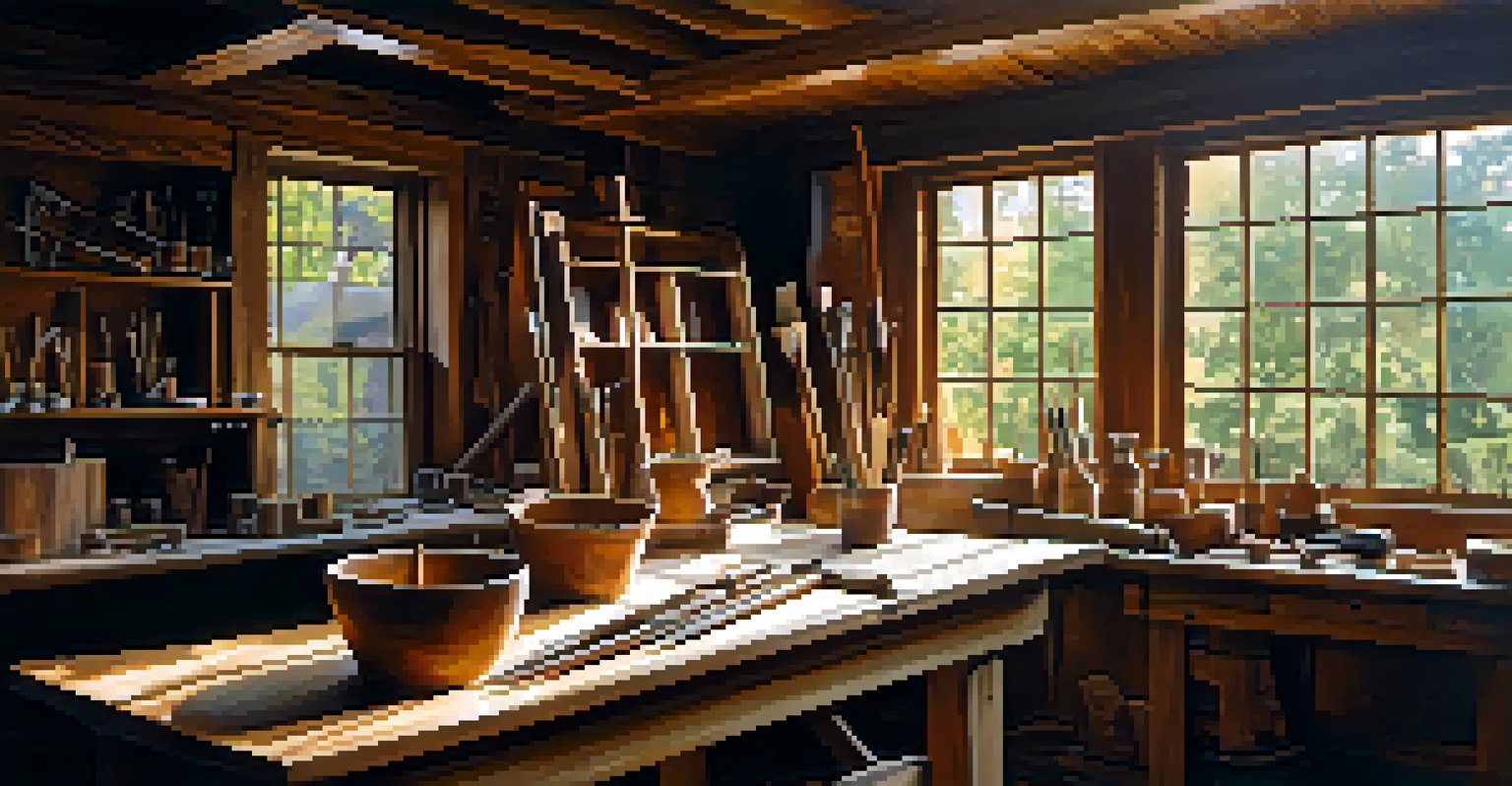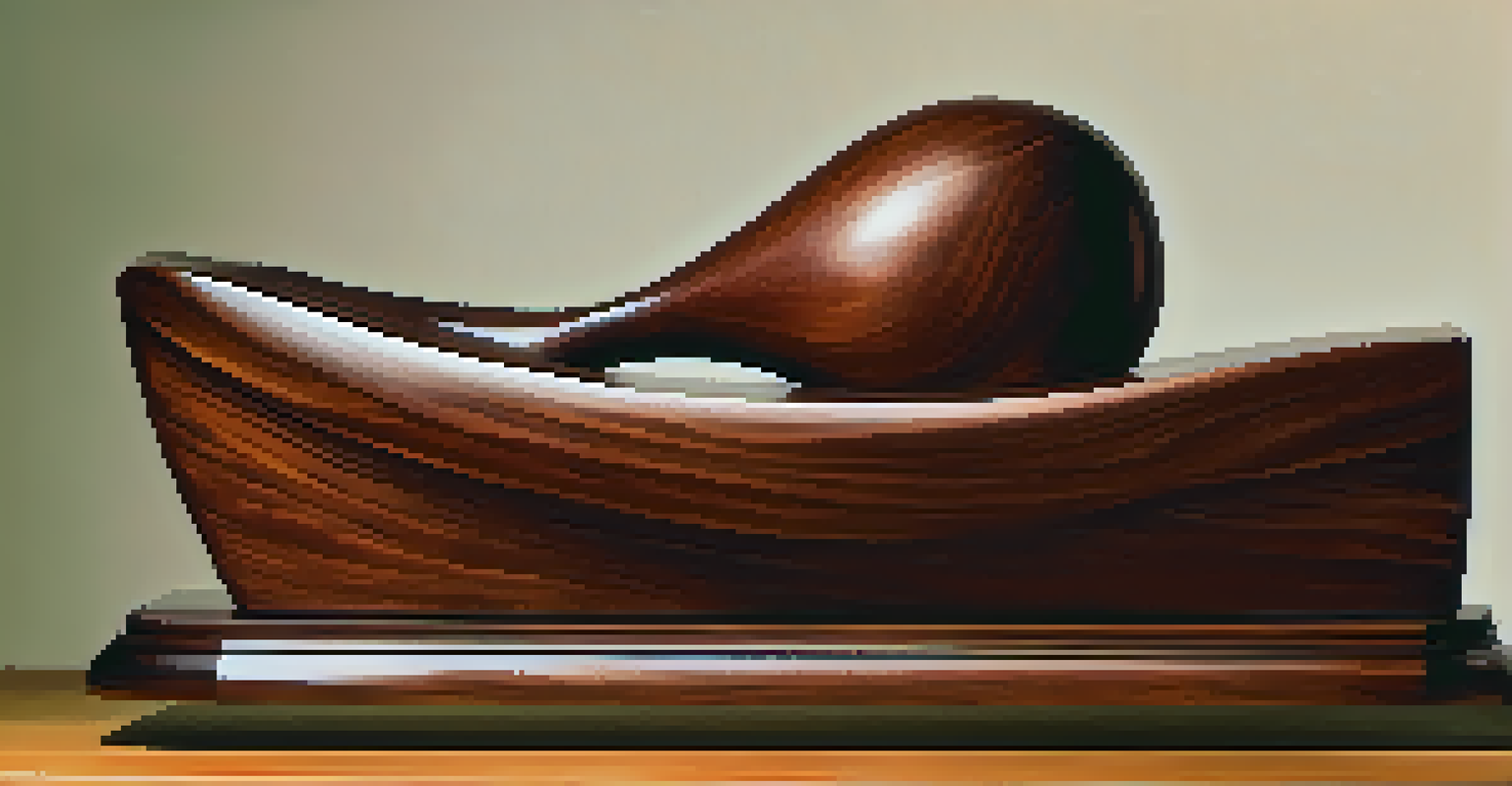Aging Wood: Effects on Carving and Craftsmanship

The Natural Aging Process of Wood and Its Importance
Wood is a living material that undergoes a natural aging process over time. As it ages, the fibers in the wood change, affecting its texture, color, and overall integrity. This process is crucial for artisans who work with wood, as understanding these changes can lead to better craftsmanship and more informed choices in their projects.
Wood is like a fine wine; it gets better with age.
For instance, hardwoods like oak or walnut can develop a rich patina as they age, enhancing their aesthetic appeal. This transformation not only makes the wood more beautiful but can also alter its workability. Carvers need to be aware of these characteristics to select the right pieces for their projects, ensuring they achieve the desired results.
Moreover, the age of the wood can influence how it interacts with tools and finishes. Older wood tends to be drier and may require different handling techniques compared to freshly cut timber. This understanding is essential for artisans looking to create high-quality pieces that stand the test of time.
Effects of Moisture Content on Aging Wood
Moisture plays a significant role in the aging process of wood, affecting its density and durability. As wood ages, it loses moisture, leading to changes in its structure that can be both beneficial and detrimental. For carvers, understanding moisture content is vital for selecting the right wood for carving and ensuring the longevity of their creations.

For example, wood that is too moist can warp or crack during the carving process, making it difficult to achieve precision. Conversely, overly dry wood may become brittle and break easily, posing challenges for intricate designs. Carvers must find a balance, often conditioning the wood to reach an optimal moisture level before starting their work.
Aging Wood Enhances Craftsmanship
Understanding the natural aging process of wood allows artisans to make informed choices, leading to better craftsmanship and more beautiful creations.
Additionally, different species of wood have varying moisture retention capacities. Knowing how each type of wood behaves with humidity changes can help artisans choose materials that suit their crafting environment, ultimately leading to better outcomes in their projects.
Aging Wood: Aesthetic Changes and Their Appeal
One of the most noticeable effects of aging wood is its aesthetic transformation. Over time, wood develops a unique character, often reflected in its color, grain, and surface texture. This natural aging process can create stunning visual effects that many artisans strive to achieve in their work.
The beauty of wood lies not just in its form, but in its history.
For instance, a piece of cherry wood might deepen in color from a light pink to a rich reddish-brown as it ages, adding warmth to any carving. Similarly, softer woods like pine can develop a silvery hue when exposed to sunlight, giving them a rustic charm that appeals to many buyers. These changes can enhance the artistic value of a piece, making it more sought after.
Moreover, the unique patterns and textures that emerge from aging can serve as inspiration for carvers. By embracing the natural beauty of aged wood, artisans can create pieces that tell a story, showcasing not only their skill but also the history of the material itself. This connection to nature adds a layer of depth to their craftsmanship.
The Role of Aging in Wood’s Structural Integrity
Aging wood affects not just its appearance but also its structural integrity. As wood ages, it may become more stable or, in some cases, more susceptible to damage. Understanding these changes is crucial for carvers to ensure that their projects are not only beautiful but also durable.
For example, well-aged wood can be less prone to warping and splitting, making it an excellent choice for intricate carvings. On the other hand, some older woods may develop internal cracks or weaknesses that can compromise their strength. Carvers should examine the wood carefully, looking for any signs of deterioration before starting their work.
Moisture Levels Impact Wood Quality
The moisture content of wood significantly affects its density and durability, making it essential for carvers to select the right material for their projects.
Additionally, the way wood is aged—whether naturally or through controlled processes—can influence its performance. Kiln-dried wood, for instance, may exhibit different characteristics compared to air-dried wood. By understanding these factors, artisans can make informed choices that enhance the longevity and quality of their crafted pieces.
Tools and Techniques for Carving Aged Wood
Carving aged wood requires specific tools and techniques tailored to its unique properties. As wood becomes older, it often hardens and may need sharper or specialized tools to achieve desired results. Understanding the right equipment can make a significant difference in the carving process.
For example, using high-quality chisels with precise edges can help carvers navigate the tougher fibers of aged wood. Additionally, employing techniques like power carving can allow artisans to work more efficiently, especially with denser materials. Learning to adapt tools and methods to suit aged wood is essential for creating intricate designs.
Moreover, experimenting with different carving techniques can yield surprising results when working with aged wood. Carvers might find that certain methods enhance the natural patterns in the grain, leading to unique artistic expressions. Embracing these challenges can elevate craftsmanship and allow for greater creativity in the carving process.
Preserving the Character of Aged Wood in Craftsmanship
Preserving the character of aged wood is a key consideration for artisans dedicated to craftsmanship. Many woodworkers aim to highlight the natural beauty and imperfections that come with aging rather than concealing them. This philosophy can lead to stunning pieces that celebrate the wood’s history.
For instance, leaving knots and grain variations visible can add charm and uniqueness to a carved object. This approach not only respects the material but also tells a story of its journey through time. Artisans who embrace these features often find that their work resonates more deeply with viewers and collectors.
Preserving Wood's Natural Beauty
Artisans aim to highlight the unique characteristics of aged wood, creating pieces that celebrate its history and enhance its natural beauty.
Additionally, using finishes that enhance rather than mask the wood’s natural beauty is crucial. Oils, waxes, and natural stains can bring out the rich colors and textures of aged wood while providing protection. By prioritizing preservation, craftsmen can create pieces that are not just functional but also artful representations of the wood’s life.
The Future of Craftsmanship with Aging Wood
As the appreciation for handcrafted items continues to grow, the role of aging wood in craftsmanship is becoming increasingly significant. More artisans are recognizing the value of working with aged materials, both for their aesthetic qualities and their historical context. This trend encourages a deeper connection between the creator and the material.
Moreover, the sustainability movement is prompting woodworkers to seek out reclaimed or salvaged wood, which often comes with its own unique aging characteristics. By incorporating these materials into their projects, artisans can create pieces that not only tell a story but also promote responsible crafting practices. This approach resonates with consumers who value sustainability.

Ultimately, the future of craftsmanship with aging wood looks promising. As artisans continue to explore the nuances of aged wood, they will likely push the boundaries of traditional techniques, leading to innovative designs and methods. This evolution will not only enhance the art of carving but also ensure that the beauty of aged wood is celebrated for generations to come.